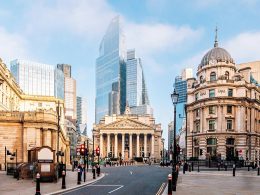What is ESG, and why should investors care?
Shoppers looking for “healthy food” must contend with a growing number of labels: organic, low-calorie, non-GMO, all-natural and many more. What you choose depends on your personal preferences and goals. Increasingly, investors are finding themselves in a similar situation. Almost 70% of investors think it’s important to invest in companies with a positive social impact.1 But sorting through the vocabulary of responsible investing can be confusing.
As Invesco’s Global Head of Responsible Investment and Proxy Governance, much of my role involves educating and collaborating with investors, asset owners, clients and the industry to share Invesco’s view of responsible investing. In this blog, I will explain responsible investing at a high level and then highlight how we at Invesco approach this critical issue.
Explaining ESG
Of all the acronyms associated with responsible investing, ESG may be the most critical. It stands for “environment, social and governance.” Investing according to ESG principles means that a portfolio manager is considering environmental, social and governance risks when selecting companies and countries in which to invest.
Ethical Investment Research Services (EIRIS), a European ESG research provider, has identified as many as 250 different ESG criteria. The table below shows just a few.
| Environment | Social | Governance | |
|---|---|---|---|
| Environment impact and risk management | Human rights | Board practice and structure | |
| Climate change impact and risk management | Supply-chain labor standards | Anti-bribery practices | |
| Biodiversity impact and risk management | Relations with customers and suppliers | Codes of ethics | |
| Water scarcity and risk management | Relations with employees | Board-level gender diversity |
Source: EIRIS global sustainability ratings, as of May 17, 2017.
Why are ESG factors important?
Environmental and social factors – such as food, water and energy security; access to natural resources; climate change; human rights; and supply chain labour standards – present material issues for businesses and the corporate world. And poor corporate governance practices – such as corruption, a lack of board diversity or poorly designed executive compensation plans that are not aligned with investor interests – can also impact shareholder value.
Responsible investing requires investors and companies to take a wider view, acknowledging the full spectrum of long-term risks and opportunities.
How are ESG considerations implemented in portfolios?
In the past, ESG issues typically resulted in the exclusion of certain industries (such as tobacco or alcohol companies) or certain countries (like South Africa during apartheid) from investment portfolios. This was referred to as SRI or socially responsible investing. While such “exclusion” techniques are still widely used and still the predominant ESG strategy, ESG considerations are incorporated in investment decisions in a variety of ways today.
The Global Sustainable Investment Alliance has classified ESG strategies into seven categories
- Negative/exclusionary screening
- Positive/best-in-class screening
- Norms-based screening
- Integration of ESG factors
- Sustainability-themed investing
- Impact/community investing
- Corporate engagement/shareholder action/active ownership
Exclusionary screening is the oldest, and perhaps still the best-known, ESG method. It refers to avoiding entirely the securities of companies or countries that do not meet specific ESG criteria.
Best-in-class screening gives preferential selection to companies with better or improving ESG performance relative to their sector peers.
Norms-based screening selects investments that meet minimum standards of business practice, typically based on international norms such as the UN Global Compact, for example.
ESG integration refers to the systematic and explicit inclusion of ESG risks and opportunities in investment analysis. However, unlike the best-in-class screening method, ESG integration does not necessarily require a manager to overweight companies based on ESG criteria.
A number of investment themes are based on ESG issues, including clean tech, green energy and sustainable forestry and agriculture. (Thematic investing is, of course, not confined to ESG issues.)
Impact investing refers to investing with the intention of generating social and environmental benefits alongside a financial return.
This refers to the practice of engaging with companies on ESG issues. So, rather than just excluding a company as a possible investment on ESG grounds, ownership rights can be used to encourage change. Some investors may use highly publicized and confrontational measures, whereas others may prefer a more discreet, “behind the scenes” approach. (It’s important to note that “active ownership” is not necessarily the same as “activist investing,” an approach used in particular by certain hedge funds with the aim of bringing about change in the management and operation of a company.)
ESG at Invesco
At Invesco, we’ve developed a wide range of sustainability-themed solutions (with $54 billion in assets across nine investment centers around the world), and our investment teams across equities, fixed income and alternatives are empowered to incorporate ESG analysis into their unique investment processes and philosophies.
This approach preserves an “entrepreneurial” environment among our teams that leads to the development of key market products that are unique.
At Invesco, we believe that a grassroots, investor-led, investor-driven approach results in a best-in-class responsible investment framework because it is “owned” by the key decision makers – our fund managers. We employ a “player/coach” model that ensures that ESG best practices in key asset classes are shared across our broad framework by fund managers (in coordination with our team) working to share their best practices with other fund managers.
The hallmark of Invesco’s ESG approach as a firm is active ownership.
In our function as fiduciaries for our clients, we see our role as business owners rather than shareholders. We believe that active ownership is the single most effective mechanism to drive responsible investment and strong investment stewardship. This involves purposeful engagement with companies, on-site due diligence and our own internal governance committees.
This post was originally published at Invesco Canada Blog
Copyright © Invesco Canada Blog
















